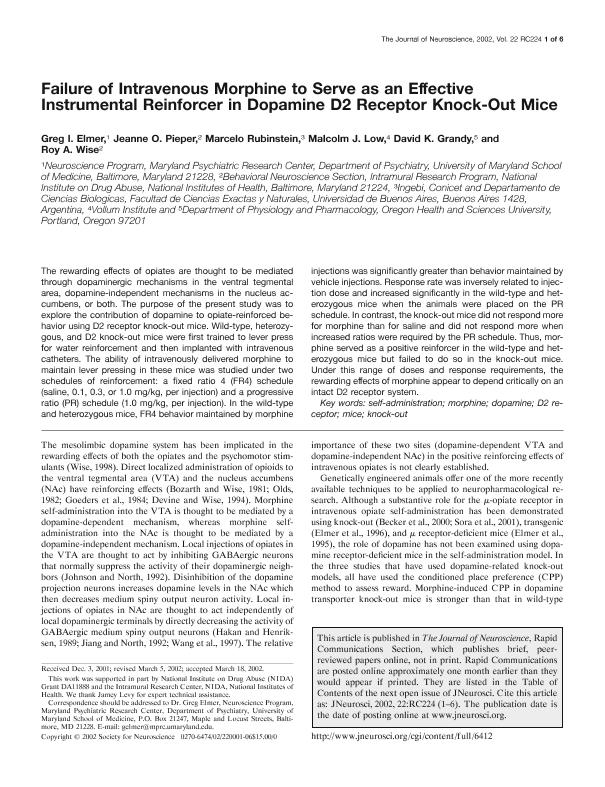Artículo
Failure of Intravenous Morphine to Serve as an Effective Instrumental Reinforcer in Dopamine D2 Receptor Knock-Out Mice
Elmer, Greg I.; Pieper, Jeanne O.; Rubinstein, Marcelo ; Low, Malcolm J.; Grandy, David K.; Wise, Roy A.
; Low, Malcolm J.; Grandy, David K.; Wise, Roy A.
 ; Low, Malcolm J.; Grandy, David K.; Wise, Roy A.
; Low, Malcolm J.; Grandy, David K.; Wise, Roy A.
Fecha de publicación:
05/2002
Editorial:
Society for Neuroscience
Revista:
Journal of Neuroscience
ISSN:
0270-6474
Idioma:
Inglés
Tipo de recurso:
Artículo publicado
Clasificación temática:
Resumen
The rewarding effects of opiates are thought to be mediated through dopaminergic mechanisms in the ventral tegmental area, dopamine-independent mechanisms in the nucleus accumbens, or both. The purpose of the present study was to explore the contribution of dopamine to opiate-reinforced behavior using D2 receptor knock-out mice. Wild-type, heterozygous, and D2 knock-out mice were first trained to lever press for water reinforcement and then implanted with intravenous catheters. The ability of intravenously delivered morphine to maintain lever pressing in these mice was studied under two schedules of reinforcement: a fixed ratio 4 (FR4) schedule (saline, 0.1, 0.3, or 1.0 mg/kg, per injection) and a progressive ratio (PR) schedule (1.0 mg/kg, per injection). In the wild-type and heterozygous mice, FR4 behavior maintained by morphine injections was significantly greater than behavior maintained by vehicle injections. Response rate was inversely related to injection dose and increased significantly in the wild-type and heterozygous mice when the animals were placed on the PR schedule. In contrast, the knock-out mice did not respond more for morphine than for saline and did not respond more when increased ratios were required by the PR schedule. Thus, morphine served as a positive reinforcer in the wild-type and heterozygous mice but failed to do so in the knock-out mice. Under this range of doses and response requirements, the rewarding effects of morphine appear to depend critically on an intact D2 receptor system
Archivos asociados
Licencia
Identificadores
Colecciones
Articulos(INGEBI)
Articulos de INST.DE INVEST.EN ING.GENETICA Y BIOL.MOLECULAR "DR. HECTOR N TORRES"
Articulos de INST.DE INVEST.EN ING.GENETICA Y BIOL.MOLECULAR "DR. HECTOR N TORRES"
Citación
Elmer, Greg I.; Pieper, Jeanne O.; Rubinstein, Marcelo; Low, Malcolm J.; Grandy, David K.; et al.; Failure of Intravenous Morphine to Serve as an Effective Instrumental Reinforcer in Dopamine D2 Receptor Knock-Out Mice; Society for Neuroscience; Journal of Neuroscience; 22; 10; 5-2002; RC224-RC224
Compartir
Altmétricas



